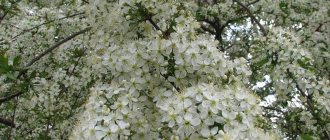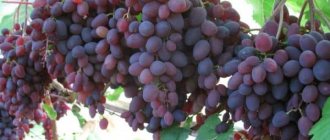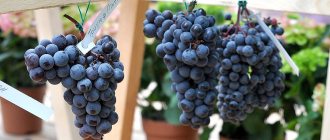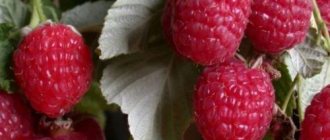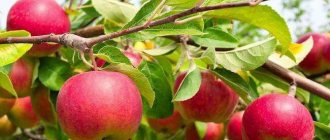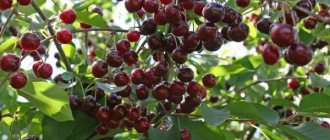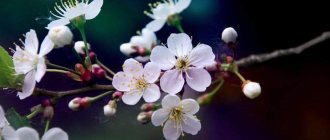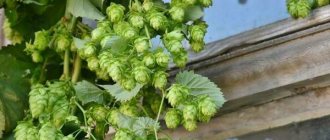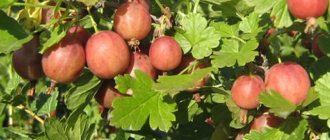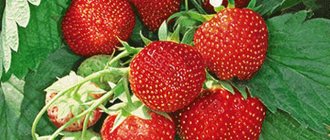Chernokorka is a medium-ripening cherry that tastes more like cherries. Sweet, with a slightly noticeable sourness.
Bred by Ukrainian breeders. Plantings of trees of this variety began to spread en masse on private plots of the southern and central regions, first in Ukraine, and then gradually moving along the same latitude in Russia. This variety is especially popular in the Kherson, Nikolaev, Dnepropetrovsk, Kirovograd, and Odessa regions. And also Krasnodar and Stavropol territories.
Black-crust cherry has its own characteristics of planting, growing and care. How to get high yields with less labor will be discussed in this article.
Description and characteristics of the variety
A tree-like shrub plant, reaching a height of about 3 meters, self-sterile. The tree blooms very beautifully, there are a lot of inflorescences, but you won’t be able to collect a lot of fruits from a lonely cherry tree. Therefore, it is not recommended to plant it alone. Need pollinators nearby. Has good shoot recovery ability. Gardeners use this to renew the crown and extend the life of Chernokorka cherries. Below is a brief description of the tree and berries.
Yields from a mature tree are high and annual. It begins to bear fruit 3–4 years after planting.
Tree
The tree is branched, the crown is not thickened. The branches are slightly drooping, strong, covered with dark brown bark. The leaf blade is oval, ellipsoidal in shape. The edges are jagged. The outer surface is dark green, and the bottom of the leaves is slightly lighter. The veins are well defined. Blackbark usually blooms in mid-May. The flowers are white, five-petaled, collected in inflorescences of 5-6 pieces.
The tree is frost-resistant, but can only tolerate short-term drops in temperature. Prolonged frosts can lead to the death of young plants, so Chernokorka cherry trees are more acclimatized in the southern regions of our country. But they don’t take root in the northern regions. Read about varieties for the Urals.
Fruit
The berries are dark burgundy in color, closer to black. Hence the name of the variety - Chernokorka. The weight of one fruit is from 4.2 to 4.5 grams. The skin is thin and shiny. The pulp is very juicy, sweet with notes of sourness, dense consistency. More like super early varieties of cherries. The juice of the berries is a rich burgundy color. The shape of cherries is round. The seed occupies 7% of the total mass of the berry and is easily separated from the pulp. The stalk is medium and long, even when the cherries reach ripeness it holds tightly. And this is one of the indicators of good transportability of the berries of this variety.
Cherries are three times richer in iron than apples.
Planting Chernokorka cherry
Chernokorka seedlings are planted in early spring. This is the optimal period, since autumn planting can lead to the death of the tree due to early frosts.
The planting pit is prepared a month before planting the cherries. The size of the hole depends on the volume of the root system of the seedling. It is better to make it large: up to 1 m wide and up to 0.6 m deep. For more effective rooting, organic matter and superphosphate are added to the hole in equal volumes. The root of the seedling is cut to a third of its length before planting. After placing the root system in the hole, an earthen roller is poured around the planting hole. In the future, it will prevent water from spreading when watering.
The size of the planting pit for cherries depends on the volume of the root system of the seedling
Some rules for planting Chernokorka:
- A bare-rooted specimen is planted only in spring. Autumn is also suitable for trees in containers.
- When planting, the seedling is not deeply buried, and the root collar is placed approximately 5 cm above the soil level.
- In the spring, long or improperly formed shoots are pruned off acquired trees.
- After planting, cherries are watered regularly and a lot.
Compliance with these rules will allow you to grow a healthy tree that produces a good and high-quality harvest.
Peculiarities
Having decided to plant a cherry orchard or even just one tree, the gardener looks for a variety that would meet all the necessary requirements: winter hardiness, resistance to stone fruit diseases, self-pollinating, good yield, transportability. Chernokorka does not meet all these requirements: it is better to grow it in the south of the country. Still, it can withstand a drop in temperature, but only if it was short-term. Resistance to diseases and pests is low. But transportability is good: berries can be transported over long distances. And, of course, what sets Chernokorka apart from other cherries is its taste - it is sweet, delicate with a barely noticeable sourness. Below is a brief overview of the characteristics of Chernokorka cherries:
- Winter hardiness is average. The tree may not be able to cope with severe, prolonged frosts. That is why the variety is zoned in the south of the country, where there are winter temperature drops, but they are short-lived;
- Disease resistance. The variety has very weak immunity against stone fruit diseases and pests. At the beginning of summer, you can notice the first signs of coccomycosis on the leaves - brown spots on the upper part of the leaf. If the disease is not dealt with, young trees may lose all their leaves during the growing season. The variety is moderately resistant to monilial burn, clasterosporia (hole spot);
- Pollinators. Chernokorka is a self-sterile variety. Therefore, it needs pollination. The best pollinators are Donchanka, Shalunya, Anadolskaya, Kharitonovskaya, Griot Podbelsky, Besseya, Lotovka rozlozistaya, Shchedraya;
- Ripening period and yield. Medium ripening variety. The harvest begins from the end of June to the beginning of July. Even under unfavorable weather conditions and poor plant care, you can collect about 30 kilograms of cherries from a tree. But if all agrotechnical measures are carried out on time, the cherries will please the gardener with a harvest twice as large. With age, productivity gradually decreases;
- Transportability. The stalk is firmly attached to the berry and therefore the cherries almost do not fall off at the time of ripeness. In addition, the skin of Chernokorka berries is durable. And these are two indicators that indicate good transportability of cherries.
Read how to treat cherry moniliosis in this article.
Disease and pest control
Like all fruit trees, Chernokorka cherry is susceptible to diseases, especially fungal ones. In conditions of high humidity, the plant is damaged by coccomycosis, after which the leaves fall off prematurely and the fruits die.
Coccomycosis most often damages cherry trees
Another danger is the spores of monilius fungi, which cause moniliosis. There are no cherry varieties resistant to these diseases, so trees need to be treated up to 2 times per season. The composition is prepared from lime and colloidal sulfur (100 g each), dissolved in 10 liters of water. You should strain the substance and spray it on the trees. You can process cherries even during the fruiting period.
Spores of the fungus monilia provoke a cherry disease called moniliosis.
Symptoms of coccomycosis appear in early June. Signs and consequences:
- the appearance of small brown spots on the surface of the leaves;
- the emergence of white fungal spores on the underside of the leaf;
- leaf fall at the end of July on the affected tree.
The main methods of disease control are collecting and destroying fallen leaves, spraying trees with fungicides before and after flowering.
Two diseases are dangerous for Chernokorkka cherries: coccomycosis and monilial burn.
| Disease | Method of treatment |
| Coccomycosis | When the first symptoms of the disease appear, treat the tree with a solution of laundry soap and ash. It should be prepared at the rate of 55 g of soap and 2 kg of ash per bucket of water. Additionally, before the beginning of the growing season and at its end, spray with a 3% solution of Bordeaux mixture. |
| Monilial burn | Affected branches must be pruned, and the cut areas must be immediately lubricated with garden varnish. Next, the plants are treated with the drug “Skor”. To do this, you need to prepare a solution at the rate of 3 g per bucket of water. For treatment, two treatments are required: before flowering and after 1.5 weeks. |
| Pest | Method of treatment |
| Aphid | Insecticides “Fitoverm” or “Aktellik” are excellent against the parasite according to the instructions. Preventive spraying before budding is acceptable. |
| cherry fly | The pest can be removed using Akara or Iskra. For prevention, the drug “Decis” is used. The solution is prepared at the rate of 2 ml per bucket of water. The plant will be protected by two treatments: before mass ripening and after 14 days. |
Important! When using any drug, follow the dosages indicated in the instructions. An excess of the active substance will not destroy the disease more effectively, but will harm the crop
Growing
Gardens of a non-industrial type, although they occupy small areas, require certain knowledge of planting, growing, and caring for. After all, there is a huge variety of conditions, such as topography, soil, microclimate, which will affect the growth and fruiting of trees. This link will tell you how to get rid of cherry trees on your property.
It is also necessary to choose the right and high-quality seedlings that must meet certain requirements:
- The height of the planting material is preferably about 1 meter. It can be either an annual plant or a biennial plant. A one-year-old cherry may only have a central conductor, while a two-year-old cherry must have lateral shoots;
- The thickness of the seedling should range from 1.5 cm to 2.5 cm. It is better not to buy ones that are too thick or thin;
- The root system should be branched and without damage.
It is better to buy grafted seedlings in a specialized nursery located in the same climatic zone where you plan to plant the garden.
Before purchasing and planting planting material, it is advisable to familiarize yourself with the basic principles of planting Chernokorka cherries.
Climatic conditions
Chernokorka cherry is more productive and begins to bear fruit earlier in the southern regions of the country. In Polesie regions it can also be grown, but trees are planted on elevated areas or southern slopes. In the central black earth region, where more severe climatic conditions, areas on the lower part of non-steep slopes are allocated for cherry orchards. Read about the best varieties of cherries for the Moscow region here.
It is better to grow Blackbark in the southern regions of the country, since the frost resistance of trees of this variety is average.
The soil
Cherry grows even on sandy and rocky soils. Trees show good survival rate and then yield on chernozems, dark chestnut and chestnut soils.
A sign of good soil for stone fruit plants can be the growth of trees in the area such as: oak, ash, hawthorn, hazel.
Landing
Cherries can be planted both in autumn and spring. In the nursery, the choice of quality material is richer in the fall. Therefore, it is at this time of year that you can buy a seedling and bury its lower part, thus preserving it until spring. Find out why cherries don’t bloom or bear fruit here.
Figure: Proper planting of a cherry seedling.
Rules for planting cherries:
- Dig a hole, place a bucket of humus in it, after mixing it with the top layer of removed soil;
- Drive a wooden or bamboo stake into the bottom of the hole;
- Place the tree, straightening the roots. Make sure that the root collar is at ground level after planting;
- Fill the hole almost to the top with soil and compact it well so that the roots come into contact with it as best as possible;
- Tie the seedling to the stake;
- Water, mulch.
It is imperative to take into account the density of tree planting. For cherry it is 5 x 3 m
Description of culture
Chernokorka cherry grows no higher than three meters. It looks like both a bush and a tree at the same time, it all depends on how it is formed. The crown of Chernokorka is wide and rounded. The drooping branches make the cherry seem squat. The leaves are dark green, medium in size, oval in shape with a sharp tip and base.
Chernokorka cherry flowers are white, large, wide open, collected in 2-5 pieces. Ripe fruits are almost black, the pulp and juice are dark burgundy. It follows from this that the Chernokorka variety is a typical griot. The berries are flat-round, quite large, their average weight is 4-4.5 g, with high agricultural technology or in a good year they can reach 5 g.
People who are far from gardening often wonder: is the Chernokorka variety cherry or cherry? Doubts arise due to the excellent sweet taste of the berries, the tasting score of which is 4.5 points. But the acid in fruits is present in sufficient quantities, it is simply softened by the high content of glucose and fructose.
Care
Chernokorka cherry is a rather unpretentious plant. Even without proper care, it will delight the gardener with sweet berries. But if you apply even a minimum of agrotechnical measures, the yield will double. First of all, you should remember that the plant's root system will develop faster and better when the soil is under black fallow. Therefore, plowing or digging must be carried out in tree trunk circles. This is usually done in the fall. Near the trunk, the loosening depth should not be more than 12 cm, and further from the trunk - 20 cm. It is necessary to carry out mulching and snow retention in winter. Timely watering, fertilizing, pruning and preparation for winter are also important. We will discuss these agricultural activities below. Also read the description of the Shpanka cherry variety in this material.
Watering
Watering trees in young orchards contributes to the early entry of cherries into fruiting, and in fruit-bearing orchards it leads to an increase in yield. When watering a tree, you need to make sure that the water wets the soil layer near it by 70–80 cm. Therefore, for one watering you need to give up to 5 buckets of water per square meter of area. Irrigation rates may vary depending on the amount of rainfall during the growing season and the climate zone where the cherry orchard is located.
Previously, gardens were irrigated using cut furrows, but now almost every gardener tries to use drip irrigation. It is very convenient to use, effective and low-cost.
Feeding
Very effective organic fertilizers are:
- Compost or manure;
- Peat feces;
- Humus.
As well as complete mineral fertilizer: nitrogen, phosphorus, potassium salts.
Blackbark can be fed with phosphorus-potassium fertilizers in the second half of summer in order to increase the frost resistance of trees of this variety.
Mix different types of mineral fertilizers only before applying them.
There are approximate rates of fertilizer application per 1 square meter of garden:
- Manure or compost – 3 kg;
- Peat feces – 1–2 kg;
- Ammonium nitrate – 20 grams;
- Superphosphate – 40 grams;
- Potassium salt – 11 grams.
Trimmings
When planting an annual seedling, you need to shorten the central conductor. If this is a two-year-old planting material and it has side branches, then it is also advisable to trim them. But so that they are not higher than the central conductor. Pruning the plant in subsequent years of growth consists of thinning the crown. After shortening the branches, the development of young shoots from the buds located below the cuts is stimulated. And this leads to an increase in yield. By pruning trees you can also control the growth of cherries in height and width.
Cherries can form strong branches, so strong shortening is applied to them only in the first year after planting in order to ensure their survival.
Preparing for winter
To increase the frost resistance of cherries in winter, in the second half of summer they are fed with mineral fertilizers, and in the fall they are watered abundantly, and then each tree trunk circle is mulched with manure, peat or sawdust. The trunk of young trees itself is wrapped with protective material. These can be bundles of straw, thick paper, etc. This will also protect the trunk of a young tree from damage by small rodents.
Cherry variety ripening period, yield indicators
In warm regions, cherries begin to bloom around the beginning of May (depending on the weather), and the berries appear in early July. The fruiting period is long and can reach 3 weeks.
The plant can produce its first harvest already in the 4th year, and full fruiting begins after about 7 years.
With proper care, you can collect from 30 to 60 kg of berries from one tree
Pros and cons of the variety
In the south of the country, the Chernokorka variety is widespread. Such cherries grow in almost every second garden plot. And there are reasons for this:
- Low trees, which makes them easier to care for;
- Good and stable yield from year to year;
- Resistance to long periods without rain;
- Beautiful, transportable berries;
- Excellent taste: Chernokorka cherries are sweet with a slight sourness.
But at the same time, it is necessary to name the disadvantages of this variety:
- Self-sterility. Flowers cannot self-pollinate. A pollinator must grow on the site. It can be not only cherries, but also sweet cherries;
- Poor immunity to stone fruit diseases. Especially for coccomycosis.
We water the plant correctly
Chernokorka comes from Ukraine, where most regions experience terrible drought in the summer. Therefore, drought resistance is genetically built into the tree. But you cannot deprive the cherry tree of the pleasure of swimming in the water. It is very important to water Chernokorka when:
- The flowering period ends and the ovaries begin to form.
- During the period when fruits begin to ripen.
This is peak load time. Therefore, high-quality watering will have a great effect on the tree and give it a lot of strength.
The basic rule when watering is to saturate the soil with water as deeply as possible - up to 50 cm. This will require at least 40 liters of water.
Seedlings are watered differently. The tree is watered more often, but in a smaller volume. Water the cherry tree once every 7-9 days, pouring about 10 liters of water at a time under the root.
conclusions
Chernokorka cherry has won the sympathy of gardeners in the south of the country with its productivity, beautiful sweet berries that have good transportability. But at the same time, in order to obtain good harvests from year to year, it is necessary to apply the following agrotechnical measures:
- Watering. It is especially important in the southern regions in summer and autumn.
- Feeding. Both mineral and organic fertilizers are used. To increase frost resistance, it is advisable to fertilize trees in the second half of summer.
- Trimmings. Cherry grows very quickly, so annual thinning of the tree is required.
- Since Chernokorka is susceptible to diseases, it is necessary to constantly inspect the tree and carry out preventive treatments.
How to collect and preserve the harvest
You need to start harvesting cherries from the most illuminated side. This is where the berries ripen earlier. Harvesting should only be done in dry weather in the morning or evening. If it rained the day before, it is better to wait, allowing the berries to dry. Wet fruits will spoil very quickly. Ripe Blackcrust does not fall off, so you don’t have to worry about losing your harvest.
The fruits of these cherries have a wet tear, which can make picking somewhat difficult. If you tear off a berry without a tail, it will spoil very quickly, so this method is only suitable for urgently eating juicy cherries or processing them. In order for the cherry to remain in the refrigerator for several days without damage, it must be picked with its tail. You can use scissors to cut off half the stalk. This way, both branches and fruits will remain unharmed. The plucked whole cherries are immediately placed in small containers that have holes for ventilation to prevent mold.
Cherries should be picked only in dry weather; wet berries spoil quickly
Chernokorka cherry is a universal berry. You can make many delicacies from it: tasty and aromatic jam, thick jam, cherries in their own juice, compote. Fruits placed in plastic bags and frozen can be stored for a long time.
Reviews about the Chernokorka variety
Over more than forty years of cultivation of this variety, it has gained particular popularity among gardeners, as follows from their reviews.
Well, there’s probably no need to even talk about Chernokorka - it’s good at flowering and has no equal in fruits. I don’t know what this variety of cherry is called in cultural terms, but we call it “black-crust”; its cherries ripen late, but they are sweet, large and so dark that they are almost black. This is the most favorite variety. But the bad thing is that the tree is not always productive and the tree is large.
Elol
https://sazhaemsad.ru/forum/vishnya-t414.html
For a long time I was pleased with the Chernokorka variety - the most fertile, small, but require constant protection from moniliosis.
ppima
https://forum.prihoz.ru/viewtopic.php?t=1148&start=1260
Gardeners who grow the Chernokorka cherry variety on their plots note its good yield, juicy and tasty fruits and resistance to different weather conditions. The disadvantages include the need to plant pollinator trees and carry out regular preventive spraying against fungal diseases.
